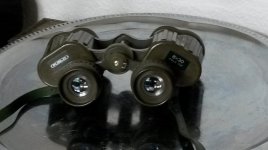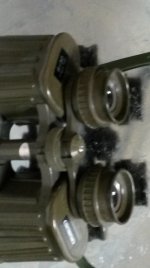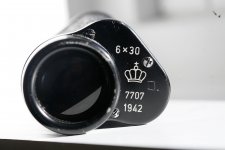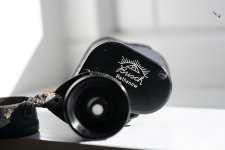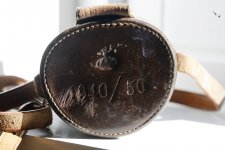I don't think so.
I think, Jerry, that you are referring to the two codes stamped into the metal of the binoculars. I think JB and JE numbers.
The yellow oval stickers, maybe more often found in cameras quite often have numbers on them.
You have to guess at the decade and then the first number is the year in that decade.
The second number is the month. I think April is month 1 and January month 0. This is not a perfect system as it seems that no optics were made in February or March. However, it is better than nothing and optics made in February or March may well have a 1 is the last digit,.
I think that the white ovals also sometimes have numerals but sometimes these are single digits, which may refer simply to the year of the decade. Quite often, however, the white ovals do not have numerals so that one cannot date the binocular. Sometimes though, if you have the paperwork you can date them that way.
There are fairly numerous code number and letters systems on lenses that indicate either the number of lens elements and lens groups, or which factory the lens was made in. And in the case of Kodak and Hasselblad you can easily tell the year of manufacture. There are also a lot of other makes, which have their own codes but I cannot remember the actual codes of these.
In addition, Dallmeyer lenses made in World War II have their own code letters. I had approximately 20 to 30 36 inch F/6.3 lenses and each of them was listed in the original Dallmeyer codebook which had handwritten entries with the dates of manufacture of each of the lenses. Quite often these were VV followed by a number or UU followed by a number. Because of wartime haste and also a very hard life on the F52 cameras the quality of these lenses varied enormously. Some were good, some were pretty awful. But even the awful ones did their job well. In some instances they are apparently hand figured aspheric, but unfortunately it is impossible to know which ones have this simply by looking at them.
The spherical aberration of the 36 inch F/6.3 cleared at F/8.7 and after that even the bad ones are okay. They were probably used at F/11 and normally used yellow or red filters. The exposures were changed mainly by interchangeable large shutter units that slotted into the back of the cameras.
Other types of Dallmeyer lenses also had similar numbers but I didn't often check them in the very large manufacturers logbook. I think that most of these logbooks still exist.
Similarly Taylor Hobson, and the National optics company or NOC had their own numbers. For instance on the 20 inch F/5.6 Aviars, which were much improved by F/7. These numbers often started with TT for Taylor Taylor Hobson.Then there were shadow factories dotted around, many around the Leicester area, but also in other parts of Britain, which had their own system, in some cases the lenses were completely unmarked. Some of the metalwork was made of very bad quality metal which nowadays crumbles terribly. the 8 inch F/2.9 Dallmeyer Pentac is often awful nowadays both in the metalwork and in the quality of the optics Also the glass is not very good quality as we had to make do with whatever glass we could get, even Scottish glass.
Similarly, binoculars, monoculars, telescopes and other optical instruments had their own system. Military items were sometimes marked with the number 14 and an arrow. I think they were different systems for the Royal Navy, air force or army. even Canadian binoculars seem to have the British system of codes. So these code numbers don't necessarily mean that they were made in Britain.
Then in Germany there were numerous codes for all the different factories including those made in other countries. You can find a mixture where the camera bodies have one number and other parts have other numbers. There are lists of probably most of these code numbers.
Unfortunately, more modern optics have such a bewildering number system that nobody outside of the factories probably knows when the items were made. Also some of these optics are made in the tens of millions and manufactures may not wish to tell you a date of manufacture.
Soviet and Russian optics have their own numbering system.




